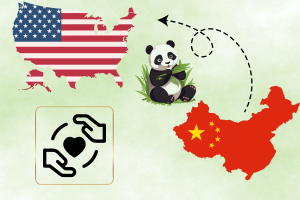In recent years, relations between the United States and China have been tense. From tariffs and trade wars to cybersecurity concerns, accusations about COVID-19 and geopolitical drama regarding Taiwan, a culture of mistrust has formed between these two nations. Leaders talk down on the other nation, anti-Chinese sentiment and xenophobia have had a resurgence in the U.S, and anti-American sentiment is strong in China. As of this summer, however, a new agreement has sparked optimism about cross-cultural relations between China and the U.S.

The agreement has allotted for the addition of four pandas to American zoos, leased for ten years. Two of the pandas arrived at the San Diego Zoo in June, and two of them arrived at the Smithsonian National Zoo in Washington, D.C., in January. This came after an 11-month absence of pandas at the zoo following the recall of three pandas from the National Zoo. This also marked the end of a 29-year streak during which pandas lived at the National Zoo.
Although this may appear arbitrary at first glance, it is a critical win for building back up the relationship between China and the U.S. By providing Americans with access to an important part of Chinese culture, panda diplomacy fosters understanding and connection over cute and cuddly panda bears.
Brandie Smith, the director of the Smithsonian’s National Zoo and Conservation Biology Institute, believes that China’s gifting of pandas and the pursuant partnership surrounding preservation is a symbol of friendship that should not go undervalued. “This historic moment is positive proof our collaboration with Chinese colleagues has made an irrefutable impact. Through this partnership, we have grown the panda population, advanced our shared understanding of how to care for this beloved bear and learned what’s needed to protect wild pandas and preserve native habitat,” she said.
The core of Chinese-American political tensions is a deeper cultural divide, one in which assumptions and stereotypes rampantly dismantle human compassion, creating misconstrued conceptions about not just the other nation, but its people too. Thus, bridging the cultural divide is often essential in bridging the political divide. And what better way to accomplish this than with pandas?
However, it’s also important to consider the intentions behind panda diplomacy. Many accuse Chinese panda diplomacy as a practice with more insidious intentions, a strategy used to spread Chinese cultural influence to gain power. Many are also discontented with how China has carried out panda exchanges, noting that panda recalls have often come after American actions disliked by China.
Although there is certainly a strategic aspect of panda diplomacy, this mainly revolves around building strategic friendships in accordance with the Chinese culture of “guanxi,” defined by Cambridge University Press as “deep trade relationships characterized by trust, reciprocity, loyalty and longevity.” Building friendships is exactly what the world needs to do right now.
Even if it’s an easy stance to take for many Americans, discrediting Chinese panda diplomacy only exacerbates tensions. Even as strategic influences are at play, panda diplomacy is an example of the power of cross-cultural connections in maintaining and strengthening international relations and bringing humans closer together in pursuit of a better world. More importantly, it is a show of friendship that should be appreciated and reciprocated.